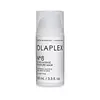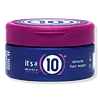What's inside
What's inside
 Key Ingredients
Key Ingredients

No key ingredients
 Benefits
Benefits

 Concerns
Concerns

 Ingredients Side-by-side
Ingredients Side-by-side

Water
Skin ConditioningDimethicone
EmollientCetyl Alcohol
EmollientPersea Gratissima Oil
Skin ConditioningGlycerin
HumectantStearyl Alcohol
EmollientEthylhexyl Olivate
Skin ConditioningBehentrimonium Chloride
PreservativeCetrimonium Bromide
AntimicrobialLimnanthes Alba Seed Oil
Skin ConditioningOryza Sativa Bran Oil
EmollientQuaternium-80
Squalane
EmollientRosa Canina Seed Extract
EmollientCeramide AP
Skin ConditioningCeramide NP
Skin ConditioningHydrolyzed Jojoba Esters
Skin ConditioningSodium Hyaluronate
HumectantSodium PCA
HumectantBis-Aminopropyl Diglycol Dimaleate
Skin ConditioningArginine
MaskingJojoba Esters
EmollientPanthenol
Skin ConditioningCarthamus Tinctorius Seed Oil
MaskingCannabis Sativa Seed Oil
EmollientGlycine
BufferingAlanine
MaskingSerine
MaskingValine
MaskingIsoleucine
Skin ConditioningProline
Skin ConditioningThreonine
Guar Hydroxypropyltrimonium Chloride
Skin ConditioningHistidine
HumectantHydroxyethylcellulose
Emulsion StabilisingPhenylalanine
MaskingAspartic Acid
MaskingPCA
HumectantPhosphatidylcholine
EmulsifyingCitric Acid
BufferingSodium Lactate
BufferingEthylhexylglycerin
Skin ConditioningSodium Benzoate
MaskingPhenoxyethanol
PreservativeBis-Cetearyl Amodimethicone
Propylene Glycol
HumectantIsopropyl Alcohol
SolventSodium Nitrate
SoothingTocopherol
AntioxidantParfum
MaskingCitral
PerfumingHexyl Cinnamal
PerfumingLimonene
PerfumingWater, Dimethicone, Cetyl Alcohol, Persea Gratissima Oil, Glycerin, Stearyl Alcohol, Ethylhexyl Olivate, Behentrimonium Chloride, Cetrimonium Bromide, Limnanthes Alba Seed Oil, Oryza Sativa Bran Oil, Quaternium-80, Squalane, Rosa Canina Seed Extract, Ceramide AP, Ceramide NP, Hydrolyzed Jojoba Esters, Sodium Hyaluronate, Sodium PCA, Bis-Aminopropyl Diglycol Dimaleate, Arginine, Jojoba Esters, Panthenol, Carthamus Tinctorius Seed Oil, Cannabis Sativa Seed Oil, Glycine, Alanine, Serine, Valine, Isoleucine, Proline, Threonine, Guar Hydroxypropyltrimonium Chloride, Histidine, Hydroxyethylcellulose, Phenylalanine, Aspartic Acid, PCA, Phosphatidylcholine, Citric Acid, Sodium Lactate, Ethylhexylglycerin, Sodium Benzoate, Phenoxyethanol, Bis-Cetearyl Amodimethicone, Propylene Glycol, Isopropyl Alcohol, Sodium Nitrate, Tocopherol, Parfum, Citral, Hexyl Cinnamal, Limonene
Water
Skin ConditioningGlycerin
HumectantDimethicone
EmollientIsopropyl Palmitate
EmollientCetyl Alcohol
EmollientBehentrimonium Chloride
PreservativeC15-23 Alkane
SolventMethyl Gluceth-20
HumectantParfum
MaskingC13-14 Alkane
SolventPhenoxyethanol
PreservativeHydroxyethylcellulose
Emulsion StabilisingMethylparaben
PreservativeDisodium EDTA
Propylparaben
PreservativeEthylparaben
PreservativeCaprylic/Capric Triglyceride
MaskingSodium Hydroxide
BufferingHydrolyzed Collagen
EmollientKeratin Amino Acids
Skin ConditioningBambusa Vulgaris Stem Extract
Phyllanthus Emblica Fruit Extract
HumectantRosa Rubiginosa Seed Oil
EmollientCoffea Arabica Seed Oil
MaskingBenzyl Benzoate
AntimicrobialLimonene
PerfumingHexyl Cinnamal
PerfumingLinalool
PerfumingWater, Glycerin, Dimethicone, Isopropyl Palmitate, Cetyl Alcohol, Behentrimonium Chloride, C15-23 Alkane, Methyl Gluceth-20, Parfum, C13-14 Alkane, Phenoxyethanol, Hydroxyethylcellulose, Methylparaben, Disodium EDTA, Propylparaben, Ethylparaben, Caprylic/Capric Triglyceride, Sodium Hydroxide, Hydrolyzed Collagen, Keratin Amino Acids, Bambusa Vulgaris Stem Extract, Phyllanthus Emblica Fruit Extract, Rosa Rubiginosa Seed Oil, Coffea Arabica Seed Oil, Benzyl Benzoate, Limonene, Hexyl Cinnamal, Linalool
 Reviews
Reviews

Ingredients Explained
These ingredients are found in both products.
Ingredients higher up in an ingredient list are typically present in a larger amount.
This ingredient is a preservative and often used for it's anti-static properties. You'll most likely see this ingredient in hair conditioners.
It does not cause irritation or sensitization in leave-on products at 1-5%.
Cetyl Alcohol is a fatty alcohol. Fatty Alcohols are most often used as an emollient or to thicken a product.
Its main roles are:
Though it has "alcohol" in the name, it is not related to denatured alcohol or ethyl alcohol.
The FDA allows products labeled "alcohol-free" to have fatty alcohols.
Learn more about Cetyl AlcoholDimethicone is a type of synthetic silicone created from natural materials such as quartz.
What it does:
Dimethicone comes in different viscosities:
Depending on the viscosity, dimethicone has different properties.
Ingredients lists don't always show which type is used, so we recommend reaching out to the brand if you have questions about the viscosity.
This ingredient is unlikely to cause irritation because it does not get absorbed into skin. However, people with silicone allergies should be careful about using this ingredient.
Note: Dimethicone may contribute to pilling. This is because it is not oil or water soluble, so pilling may occur when layered with products. When mixed with heavy oils in a formula, the outcome is also quite greasy.
Learn more about DimethiconeGlycerin is already naturally found in your skin. It helps moisturize and protect your skin.
A study from 2016 found glycerin to be more effective as a humectant than AHAs and hyaluronic acid.
As a humectant, it helps the skin stay hydrated by pulling moisture to your skin. The low molecular weight of glycerin allows it to pull moisture into the deeper layers of your skin.
Hydrated skin improves your skin barrier; Your skin barrier helps protect against irritants and bacteria.
Glycerin has also been found to have antimicrobial and antiviral properties. Due to these properties, glycerin is often used in wound and burn treatments.
In cosmetics, glycerin is usually derived from plants such as soybean or palm. However, it can also be sourced from animals, such as tallow or animal fat.
This ingredient is organic, colorless, odorless, and non-toxic.
Glycerin is the name for this ingredient in American English. British English uses Glycerol/Glycerine.
Learn more about GlycerinHexyl Cinnamal is a fragrance ingredient with a similar scent to jasmine. It can be naturally found in chamomile essential oil.
This ingredient is a known EU allergen and may sensitize the skin. The EU requires this ingredient to be listed separately on an ingredients list.
Hexyl Cinnamal is not water soluble but is soluble in oils.
Learn more about Hexyl CinnamalHydroxyethylcellulose is used to improve the texture of products. It is created from a chemical reaction involving ethylene oxide and alkali-cellulose. Cellulose is a sugar found in plant cell walls and help give plants structure.
This ingredient helps stabilize products by preventing ingredients from separating. It can also help thicken the texture of a product.
This ingredient can also be found in pill medicines to help our bodies digest other ingredients.
Learn more about HydroxyethylcelluloseLimonene is a fragrance that adds scent and taste to a formulation.
It's found in the peel oil of citrus fruits and other plants such as lavender and eucalyptus. The scent of limonene is generally described as "sweet citrus".
Limonene acts as an antioxidant, meaning it helps neutralize free radicals.
When exposed to air, oxidized limonene may sensitize the skin. Because of this, limonene is often avoided by people with sensitive skin.
The term 'fragrance' is not regulated in many countries. In many cases, it is up to the brand to define this term. For instance, many brands choose to label themselves as "fragrance-free" because they are not using synthetic fragrances. However, their products may still contain ingredients such as essential oils that are considered a fragrance.
Learn more about LimoneneParfum is a catch-all term for an ingredient or more that is used to give a scent to products.
Also called "fragrance", this ingredient can be a blend of hundreds of chemicals or plant oils. This means every product with "fragrance" or "parfum" in the ingredients list is a different mixture.
For instance, Habanolide is a proprietary trade name for a specific aroma chemical. When used as a fragrance ingredient in cosmetics, most aroma chemicals fall under the broad labeling category of “FRAGRANCE” or “PARFUM” according to EU and US regulations.
The term 'parfum' or 'fragrance' is not regulated in many countries. In many cases, it is up to the brand to define this term.
For instance, many brands choose to label themselves as "fragrance-free" because they are not using synthetic fragrances. However, their products may still contain ingredients such as essential oils that are considered a fragrance by INCI standards.
One example is Calendula flower extract. Calendula is an essential oil that still imparts a scent or 'fragrance'.
Depending on the blend, the ingredients in the mixture can cause allergies and sensitivities on the skin. Some ingredients that are known EU allergens include linalool and citronellol.
Parfum can also be used to mask or cover an unpleasant scent.
The bottom line is: not all fragrances/parfum/ingredients are created equally. If you are worried about fragrances, we recommend taking a closer look at an ingredient. And of course, we always recommend speaking with a professional.
Learn more about ParfumPhenoxyethanol is a preservative that has germicide, antimicrobial, and aromatic properties. Studies show that phenoxyethanol can prevent microbial growth. By itself, it has a scent that is similar to that of a rose.
It's often used in formulations along with Caprylyl Glycol to preserve the shelf life of products.
Water. It's the most common cosmetic ingredient of all. You'll usually see it at the top of ingredient lists, meaning that it makes up the largest part of the product.
So why is it so popular? Water most often acts as a solvent - this means that it helps dissolve other ingredients into the formulation.
You'll also recognize water as that liquid we all need to stay alive. If you see this, drink a glass of water. Stay hydrated!
Learn more about Water